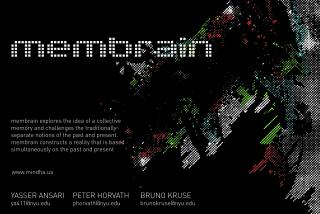Bruno Kruse
Peter Horvath
Yasser Ansari
membrain
membrain explores the idea of a collective memory and challenges the traditionally separate notions of the past and present. membrain constructs a reality that is based simultaneously on the past and present experiences of a group.
http://www.mindha.us/

Classes
Introduction to Computational Media (Thu),Introduction to Physical Computing (Tue)
Introduction to Computational Media (Thu),Introduction to Physical Computing (Tue)
At the center of the membrain project is a live video display and an interactive object representing a communal brain. Observers interact with the communal brain through proximity and touch while the live video display shows what the brain is seeing. In its default state, the brain is constantly scanning for people and possible social interactions. Once the brain detects presence, a series of carefully scripted events take place. As observers approach, the brain will begin to glow brighter. When an observer touches the brain, the brain achieves full brightness and the video display will zoom into the individual pixels that are being used to construct the live video. These pixels are all previous images captured by the brain. If the interaction is sustained and a face is detected for longer than a few seconds, a new snapshot is taken and added as a memory. This memory becomes part of the communal or collective memory. Once the snapshot is taken and added to the collective memory, observers will be able to view the most recent image by touching the brain and zooming in. The video will zoom back out as the observer's hands move away. Once the observer walks away, the brain will fall back to its dimly lit state awaiting further interaction.
membrain reconstructs the present with images and events from the past. Through this process, observers are reminded of the connection to their past memories and the impacts those experiences have on their perception of the current world. Additionally, membrain explores the idea of a collective memory.
membrain reconstructs the present with images and events from the past. Through this process, observers are reminded of the connection to their past memories and the impacts those experiences have on their perception of the current world. Additionally, membrain explores the idea of a collective memory.

